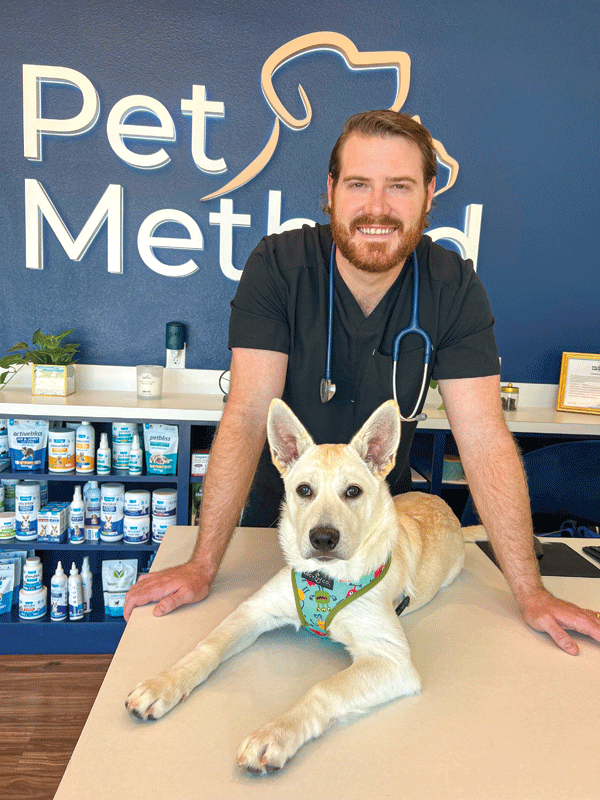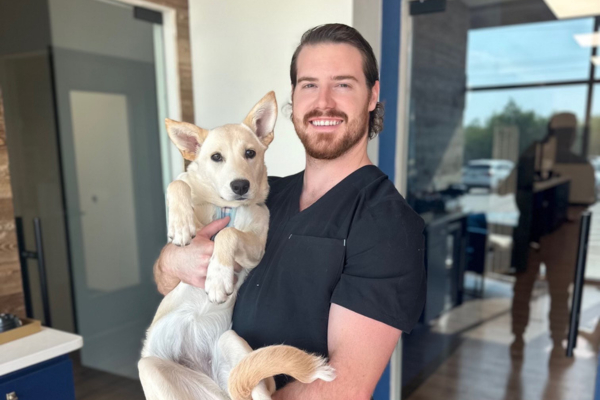
social media platform to educate pet owners on veterinary care. Photo courtesy Dr. Finn
Learning has become faster with social media. Want to try a new recipe? Tap that link. Curious about what is happening in other parts of the world? Play that reel. Want to stalk your favorite celebrity? Scroll through their feed. Need a rundown of the latest, new, and trending topics? Look it up online.
This swift and convenient access to information has opened the world and created opportunities to reach out to people. Our social media presence now has the potential to be more than just that—it can transition into influence. Take, for example, the rise of social media content creators, who we turn to (or should I say, tap?) for tips and engage for relatable content. In the realm of pet care, Hunter Finn, DVM, knows too well how to use social media to reach his audience.
“I have never liked the term influencer,” says Dr. Finn, owner of Pet Method Animal Hospital in McKinney, Tex. “… but it is true, though. Whether we know it or not, we are all influencing people every single day.” Finn says his biggest influence is education. “That has always been my goal since starting social media.”
As of press time, Finn has more than two million followers on TikTok and more than 500K followers on Instagram. He aims at leveraging his platform to share insights on animal care with engaging stories that resonate with pet owners and fellow veterinary professionals alike.
Finn’s dedication to animal care extends beyond social media. Apart from running his own practice, one of his more recent endeavors is becoming part of Elanco’s Parvo Defenders Task Force, an initiative to save one million puppies from parvovirus by 2030.
We caught up with Finn recently to learn more about the cases he sees in his practice, how he integrates the first USDA-conditionally approved Canine Parvovirus Monoclonal Antibody (CPMA) treatment to handle parvo cases, and his work as a veterinarian-influencer.

1) What are some of the most common cases you see in your practice?
“We see everything from foreign body ingestions to chocolate toxicity, rat poison ingestion, being hit by cars, broken bones from jumping off staircases, cruciate ligament tears, cancer patients, and, of course, allergic dogs.”
2) As the peak of canine parvovirus season rolls in, are you seeing an increasing number of cases in your practice?
“We are seeing many parvo cases in the Dallas-Fort Worth region and expect to see them throughout this summer. Two notable cases recently occurred: a 12-week-old Bernese Mountain dog mix and a six-month-old Doberman.
The Bernese had no prior vaccinations, but the Doberman had a full set of puppy vaccines. Both dogs received the monoclonal antibody (mAb) treatment, Canine Parvovirus Monoclonal Antibody (CPMA), and within two days of testing positive and three days after treatment, had made huge turnarounds in their clinical status. Both were treated as outpatients as well due to financial constraints. These pups are both thriving and living their best
lives now!
From my experience, if you can help keep the puppy stable with supportive care and incorporate the mAb medication into the treatment protocol, they are almost ready—if not ready—to walk out the door on day four of treatment. Otherwise, many parvo patients could be hospitalized for an entire week and still be quite sick. I believe this treatment is a huge additional tool to our current supportive care arsenal for parvo puppies and gives them a much better prognosis.”
3) Has using CPMA impacted your practice guidelines for handling parvo cases? If so, how? Describe how this affected your staff/team.
“This is now included in every single parvo treatment plan and prioritized over everything else. In my opinion, CPMA and fluid therapy are of equal importance at this point. It gives the team more hope when diagnosing a dog with parvo—we finally have a treatment option in addition to the supportive care we historically give.
If you can test for parvo, you can now treat parvo with CPMA. This decreases the emotional and physical burden on our staff and team while allowing us to treat more animals more quickly.”

4) As with other things, people may hesitate with a new treatment. How do you educate pet owners about parvovirus and the benefits of using this new treatment option?
“I have had no pushback about this treatment and, in fact, have been referred to clients from other veterinary hospitals because I have CPMA in stock. People are actively seeking this option out. They understand it gives their pup a better fighting chance.
People don’t realize how prevalent and hardy parvovirus is. Just because you have a clean neighborhood doesn’t mean you don’t have parvovirus in the soil. It is important for pet owners to self-report and help veterinary professionals identify any outbreaks in real time.
CPMA gives us hope. It shows the veterinary profession is always evolving and even some of our most historically awful diseases can be combatted as we continue to progress. I would encourage my fellow veterinarians and those in the animal health community to check out DefeatParvo.com, sign the pledge, and be part of the important mission to save a million puppies from parvo by 2030.”
5) You have a massive social media following. How does this influence your approach to veterinary care and
client communication?
“Social media allows me to learn better how to communicate with the public. There is so much awful misinformation on the internet by people who don’t know any better. As veterinarians, it is our duty to meet our clients and serve as a source of information so these pets are not unintentionally harmed. You can be the best and smartest doctor in the world, but if you can’t communicate, empathize, and gain people’s trust, you will not help many pets.
I have never liked the term influencer, but it is true because whether we know it or not, we influence people daily. My biggest impact is education, which has always been my goal since starting social media. It began with dancing and text on the screen, and now I’m rescuing dogs with my wife and showcasing journeys to health, surgeries, and treatments we provide for pets that maybe didn’t get the best advice from sources on the internet.”
